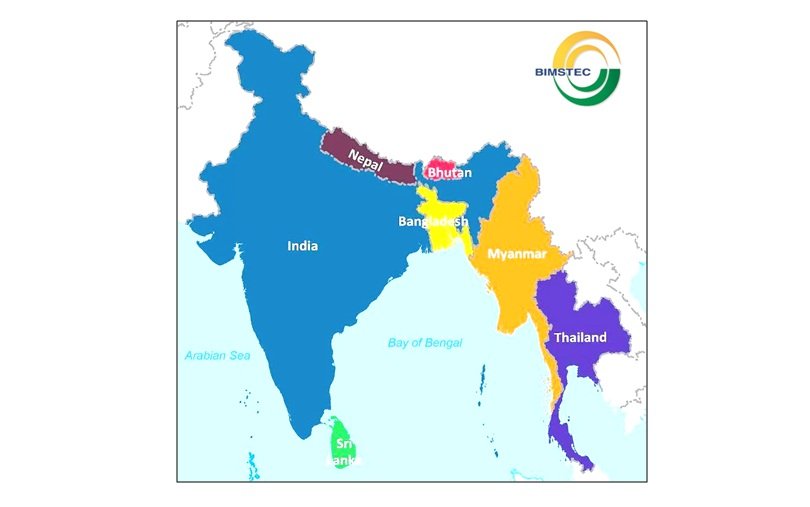
The Bay of Bengal Initiative for Multi-Sectoral Technical and Economic Cooperation (BIMSTEC) is a regional organization comprising seven member countries from South Asia and Southeast Asia. Established to foster economic and technical collaboration, BIMSTEC has emerged as a vital platform for regional cooperation. This article provides BIMSTEC’s history, objectives, structure, areas of cooperation, achievements, challenges, and future prospects.
History of BIMSTEC
BIMSTEC was founded on June 6, 1997, through the Bangkok Declaration. Initially named the “BIST-EC” (Bangladesh, India, Sri Lanka, Thailand Economic Cooperation), the organization’s name evolved to “BIMST-EC” following Myanmar’s inclusion and later to “BIMSTEC” when Nepal and Bhutan joined.
Member Countries
The seven member countries of BIMSTEC are:
- Bangladesh
- Bhutan
- India
- Myanmar
- Nepal
- Sri Lanka
- Thailand
Objectives of BIMSTEC
BIMSTEC aims to promote:
- Economic Growth: Enhancing trade, investment, and connectivity in the region.
- Technical Cooperation: Facilitating collaboration in areas such as technology, energy, and environment.
- Social Development: Addressing poverty alleviation, healthcare, and education.
- Regional Integration: Strengthening ties among South and Southeast Asian countries.
Structure and Governance
Key Organs of BIMSTEC
- BIMSTEC Summit: The highest decision-making body, comprising heads of state or government from member countries.
- Ministerial Meetings: Focused on specific sectors such as trade, energy, and transportation.
- Senior Officials’ Meetings (SOM): Prepare agendas and facilitate coordination.
- BIMSTEC Secretariat: Located in Dhaka, Bangladesh, the Secretariat oversees day-to-day activities and implements decisions.
Decision-Making Principles
- Decisions are made through consensus to ensure all members’ interests are considered.
Areas of Cooperation
BIMSTEC focuses on fourteen priority sectors, each led by a member country. Key areas include:
- Trade and Investment: Enhancing intra-regional trade and economic collaboration.
- Transport and Connectivity: Developing infrastructure and connectivity to facilitate movement of goods and people.
- Energy: Promoting renewable energy projects and power grid interconnections.
- Technology: Advancing digital technology and innovation.
- Tourism: Leveraging cultural and natural heritage to boost tourism.
- Environment and Disaster Management: Addressing climate change and enhancing disaster resilience.
Achievements of BIMSTEC
Economic Cooperation
- BIMSTEC’s initiatives have boosted intra-regional trade and investment, though significant potential remains untapped.
Connectivity Projects
- Projects like the Kaladan Multimodal Transit Transport Project and BIMSTEC Master Plan for Transport Connectivity aim to improve regional connectivity.
Energy Collaboration
- The BIMSTEC Energy Centre in India facilitates research and collaboration on energy projects.
Disaster Management
- BIMSTEC has undertaken joint initiatives to improve disaster preparedness and response mechanisms.
Challenges Facing BIMSTEC
Political and Diplomatic Issues
- Diverging national interests and geopolitical tensions among member countries can hinder collaboration.
Limited Resources
- Inadequate financial and institutional resources have slowed the implementation of BIMSTEC’s initiatives.
Connectivity Gaps
- Physical and digital connectivity among member countries remains underdeveloped.
Overlapping Memberships
- Several BIMSTEC members are also part of other regional organizations like SAARC, leading to divided focus and overlapping agendas.
Future of BIMSTEC
To realize its full potential, BIMSTEC must focus on:
- Deepening Economic Integration: Finalizing and implementing the BIMSTEC Free Trade Agreement.
- Enhancing Connectivity: Accelerating infrastructure projects and digital networks.
- Strengthening Institutional Capacity: Allocating resources to improve decision-making and execution.
- Addressing Common Challenges: Collaborating on climate change, public health, and disaster management.
- Leveraging Geopolitical Opportunities: Using its strategic location to strengthen ties with external partners and global organizations.
Conclusion
BIMSTEC represents a unique bridge between South Asia and Southeast Asia, offering immense potential for economic growth, social development, and regional integration. Despite its challenges, the organization’s focus on pragmatic cooperation and shared interests provides a strong foundation for future success. By addressing internal issues and capitalizing on emerging opportunities, BIMSTEC can become a cornerstone of regional stability and prosperity.






